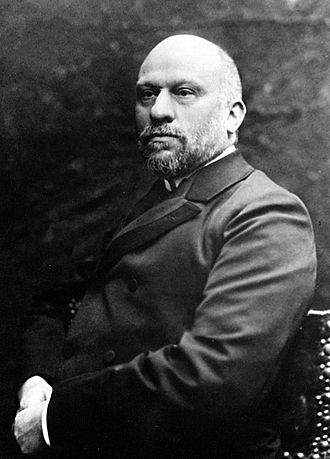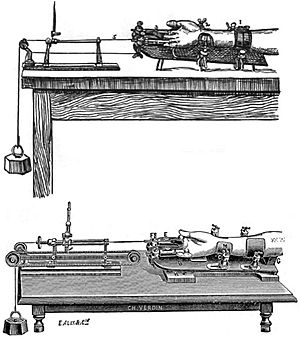Angelo Mosso facts for kids
Angelo Mosso (born May 30, 1846 – died November 24, 1910) was an Italian scientist. He was a physiologist, which means he studied how living things work. Mosso is famous for inventing the very first neuroimaging technique. This technique helped scientists see what was happening in the brain without needing surgery. He called it the 'human circulation balance'.
Mosso first noticed something interesting in patients who had skull injuries. He saw that the tiny movements (pulsations) of their brain changed when they were thinking. This made him guess that when we think, more blood goes to our brain. To test this idea, he invented his special 'human circulation balance'. This machine could measure how blood moved around the body, even in healthy people, when they were feeling emotions or thinking hard. This was a huge step! It was the first time anyone could study brain activity in this way. Today, we have more advanced tools like fMRI and PET scans, but Mosso's invention was the start of it all.
Contents
Angelo Mosso's Life and Work
Angelo Mosso was born in Turin, Italy. He studied medicine in Turin, Florence, Leipzig, and Paris. Later, he became a professor of pharmacology (the study of medicines) in 1876. In 1879, he became a professor of physiology in Turin.
Mosso created many tools to measure the pulse, which is the beat of your heart. He studied how the pulse changed when people were sleeping, thinking, or feeling emotions. In the early 1900s, he visited the United States. He wrote a book about his observations there. In 1882, he helped start a science journal called Archives Italiennes de Biologie. Many of his scientific papers were published in this journal.
Mosso's Important Books
Angelo Mosso wrote several important books during his life. Here are a few of them:
- Sulla paura (1884) and La paura (1891): These books were about fear. The 1891 book was even translated into English as Fear.
- La fatica (1891): This book was about fatigue, or being tired. It was also translated into English as Fatigue.
- Fisiologia dell' uomo sulle Alpi (1897): This book explored the physiology of humans in the Alps mountains.
- Mens Sana in Corpore Sano (1903): This title means "A Healthy Mind in a Healthy Body."
- Escursioni nel mediterraneo e gli scavi di Creta (1907): This book was about his trips around the Mediterranean Sea and the ancient discoveries on the island of Crete. It was translated into English as The Palaces of Crete and their Builders.
In 1897, Angelo Mosso was chosen to be a member of the Royal Swedish Academy of Sciences. This was a great honor for his scientific work.
Mosso's Inventions
Angelo Mosso was a brilliant inventor. He created several important tools that helped scientists understand the human body better.
Mosso's Balance
This is the 'human circulation balance' we talked about earlier. It was a special bed that could gently tilt. When a person lay on it and started thinking, more blood would flow to their brain. This tiny shift in blood would make the bed tilt slightly. Mosso could measure this tilt, showing how blood moved during mental activity. This invention was forgotten for a while but was recently rediscovered by other scientists.
Mosso's Ergograph
The Mosso's ergograph was invented in 1890. An ergograph is a device that measures how much force and how often someone can bend their fingers. It helped scientists study muscle tiredness and how our bodies get fatigued.
Mosso's Sphygmomanometer
The Mosso's sphygmomanometer was an instrument used to measure blood pressure in the arteries. This invention was an early version of the blood pressure cuffs doctors use today.
See also
 In Spanish: Angelo Mosso para niños
In Spanish: Angelo Mosso para niños



